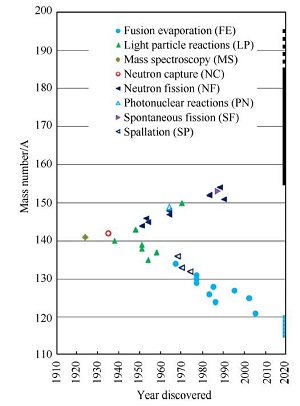|
化学史与化学史教育
|
|
 |
|
|
|
|
| “双生子元素”镨和钕的发现及其概念的发展* |
| 尚晓烁, 袁振东, 李猛** |
| 河南师范大学化学化工学院 河南新乡 453007 |
|
| Discovery of “Twin Elements” Praseodymium and Neodymium and the Development of Their Concepts |
| SHANG Xiao-Shuo, YUAN Zhen-Dong, LI Meng** |
| School of Chemistry and Chemical Engineering, Henan Normal University, Xinxiang 453007, China |
|
|

摘要:在元素发现史上,镨、钕2种元素的发现较为独特,是相伴而生的。1839年,瑞典科学家莫桑德尔在“铈土”(Cerium)中得到了锚土(didymium),提出了存在新元素的假说,但未分离出相应的单质。1882年,布劳纳利用分光镜检验出了分别属于镨和钕的吸收光带。1885年,奥地利化学家卡尔·奥尔斯·韦尔斯拔利用双硝酸盐与铵分馏结晶的方法,从“锚土”中分离出了镨和钕的单质,证实了存在新元素的假说,镨、钕元素的概念基本形成。1972—1976年间,我国化学家徐光宪提出逆流萃取理论,对分离后镨、钕单质纯度的提高做出了突出贡献。至20世纪,随着同位素化学的兴起,镨、钕元素的同位素相继被发现,形成了现代的镨、钕元素概念。总之,镨、钕的发现及其概念的发展是科学思想与科学技术融合发展的结晶。
|
|
| 关键词: 镨钕混合物,
镨元素,
钕元素,
同位素
|
|
|
| 基金资助:* 河南师范大学博士人才科研启动课题(QD2023022) |
|
通讯作者:
** E-mail:809549679@qq.com
|
| 引用本文: |
|
尚晓烁, 袁振东, 李猛. “双生子元素”镨和钕的发现及其概念的发展*[J]. 化学教育(中英文), 2024, 45(22): 123-129
|
|
| [1] |
Koo J. IEEE Transactions on Magnetics,1984,20(5): 1593-1595
|
| [2] |
Davies H A, Harland C L, Betancour R J I, et al. MRS Online Proceedings Library (OPL),1999, 577(1):27
|
| [3] |
唐政刚,张达,解志鹏,等.有色金属科学与工程,2021,12(4):112-125
|
| [4] |
李建忠.自然资源科普与文化,2021,27(2):12-19
|
| [5] |
Zepf V. Rare earth elements:What and where they are. Berlin,Heidelberg:Springer, 2013:18-20
|
| [6] |
Adunka R, Orna M V, Adunka R, et al. Carl Auer von Welsbach: Chemist, Inventor, Entrepreneur, 2018: 17-34
|
| [7] |
Cunningham C. Discovery of the first asteroid, ceres: Historical studies in asteroid research. Cham: Springer, 2016:57-74
|
| [8] |
Weeks M E. Journal of Chemical Education,1932,9(10): 1751
|
| [9] |
Hisinger W, Berzelius J J. Neues Allgemeines Journal der Chemie, 1804, 2: 397-418
|
| [10] |
Tansjö L. Carl Gustaf Mosander and his research on rare earths.Dordrecht: Springer Netherlands,1996: 37-54
|
| [11] |
Szabadváry F. Handbook on the physics and chemistry of rare earths,1988,11:33-80
|
| [12] |
Mosander C G. XXX. The London, Edinburgh,and Dublin Philosophical Magazine and Journal of Science,1843,23(152):241-254

|
| [13] |
Newton I. American Journal of Physics,1993,61(2):108-112
|
| [14] |
Kirchhoff G. IX. The London, Edinburgh, and Dublin Philosophical Magazine and Journal of Science, 1860, 20(131): 88-109
|
| [15] |
杨奇,陈三平,邸友莹,等.大学化学,2017,32(6):46-67
|
| [16] |
赵匡华. 化学通史. 北京:高等教育出版社, 1990:151-152
|
| [17] |
Kirchhoff G, Bunsen R. LXIV. The London, Edinburgh,and Dublin Philosophical Magazine and Journal of Science,1861,22(150):498-510

|
| [18] |
Voncken J H L. The rare earth elements: an introduction. Cham: Springer International Publishing, 2016
|
| [19] |
Menschutkin B N. Journal of Chemical Education, 1937, 14(2): 59
|
| [20] |
Yan C, Jia J, Liao C, et al. Tsinghua Science and Technology, 2006, 11(2): 241-247
|
| [21] |
严纯华.中国科学:化学, 2020, 50(11):4
|
| [22] |
Evans C H. Episodes from the history of the rare earth elements. Dordrecht: Springer, 2012
|
| [23] |
Kofoed-Hansen O,Nielsen K O. Physical Review,1951,82(1):96
|
| [24] |
Hoffman D C,Daniels W R. Journal of Inorganic and Nuclear Chemistry,1964,26(11):1769-1793
|
| [25] |
May E, Thoennessen M. Atomic Data & Nuclear Data Tables, 2012, 98(5):960-982
|
| [26] |
Gross J L, Claes J, Kathawa J, et al. Atomic Data and Nuclear Data Tables, 2012, 98(2):75-94
|
|
|
|